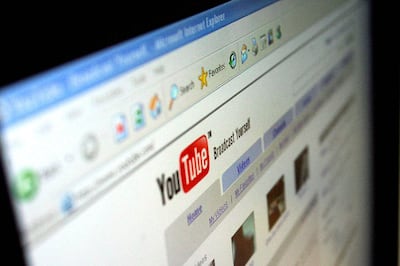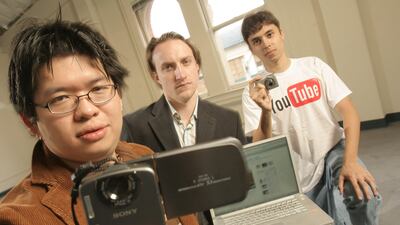Two decades ago, a startup that was supposed to be a dating website with a unique video twist accidentally created a media juggernaut. Today, we all know it as YouTube, and love it or hate it, there are admirable lessons that can be learnt from its ascent.
I can still remember when I first saw someone using the website (if you’ll forgive my millennial trip down memory lane that somewhat illustrates how old I am). I was in my undergrad university years at Northeast, Ohio. Even though we all had laptops at this point for the most part, the computer lab was still the place to be, and frankly, the place to be seen. To mix metaphors, the lab was an analogue social networking site.
I heard someone laughing and glanced over at their cathode-ray-tube display, and I saw a fellow student watching a video with some outtakes and bloopers from the TV shows Full House, Perfect Strangers and Family Matters. Making note of the YouTube logo (which hasn’t really changed all that much since 2005), I quickly opened the site as well. It was quaint and somewhat quirky, although the videos did load quickly.
For reasons I didn’t fully understand back then, it felt very important, even if the content was far from polished. I didn’t realise it at the time, nor did the millions of other millennials, but we were witnessing a huge shift – a changing of the guard and the birth of a durable, albeit continuously evolving, brand.
Video content on the web wasn’t new by any means. Microsoft offered Media Player, Apple touted QuickTime, and RealNetworks boasted RealPlayer, to name a few. Yet those formats and players largely worked within the existing infrastructure of big media companies. They gave those entities a way to put their broadcast-quality content, or at least a portion of it, online. YouTube, however, focused on the rest of us.
The name, YouTube, was no accident. The founders – former PayPal employees Chad Hurley, Steve Chen and Jawed Karim – wanted to take all that content that was being recorded on digital cameras and give it a home on the web.
Top 10 most viewed YouTube videos — in pictures
As I wrote earlier, the company’s initial foray into the world of online dating was short-lived – few, if any, used the site. But the founders realised that there was the germ of a good idea with what they created.
“I just talked to both of you on the phone. I’m 100 per cent convinced that this can be huge if executed right,” read an email Mr Karim sent to his co-founders in February 2005.
“Timing is perfect because video digital cameras are exploding right now. Our site should be video-only to emphasise the unique aspect of our site … bandwidth costs will be high, but bandwidth is getting very cheap, so we might be okay,” he added, which in hindsight seems incredibly prophetic.
Perhaps most importantly, YouTube revolved around something called a buffered streaming model, which at the time was a sharp departure from videos that had to be downloaded. The quality of the videos was affected slightly, but for most people it was good enough and made for a far superior and quicker video consumption experience.
The platform took off as the trio predicted. Within one year, it was purchased by Google, which had seen YouTube eclipse its own video sharing offerings.
Some accused the founders of selling out, while others worried that Google might ruin what made the platform unique and successful. Yet the YouTube branding remained, and Google took advantage of its size to give the community-driven video content site unprecedented server space, reach and technical support. This made the site a go-to source for anybody looking to be entertained, to upload a video, or to host a live video stream.
YouTube, of course, is not without controversy. Of the billions of videos on the platform, there’s inevitably copyright infringement, with the legacy media companies finding themselves both victims and content creators. Although the entity continuously implements new technological innovation to try to penalise and blunt the problem, there are still many poached pieces of content on the site, with nefarious actors always finding new ways to game the system.

Some have also accused YouTube of essentially being a brain-drain for younger consumers, especially as the debate over the potential side-effects of social media begins to crescendo. Others have criticised it for being addictive as well. Yet there haven’t been many accusations thrown at YouTube that haven’t already been aimed at other platforms in the digital space.
That leads me to YouTube’s perhaps most impressive, and at once challenging, pivots.
The site is now trying to knock TikTok off its social media pedestal, while the China-based video app currently fights a multi-front war against regulators in the US. YouTube isn’t alone in this pursuit of trying to dethrone its rival. Meta’s Instagram also stands to gain from TikTok’s regulatory woes, and it’s even gone as far as advertising on TikTok to try to poach users who are frightened that their favourite social media video platform might cease to exist in the US.
Yet YouTube has a distinct, schematic advantage. Why? Because it has been accumulating videos since 2005, giving it more than enough content to incorporate a TikTok-like algorithm and quickly scale it. YouTube clearly understands this, and it has been telling content creators both young and old to use its Shorts vertical video feature, making it almost indistinguishable from TikTok to the untrained eye.
Of course, it remains to be seen if YouTube will become the next TikTok, yet the fact that the company is quickly trying to adapt shows that it hasn’t strayed too far from the lessons it learnt back in 2005 when it was a fledgling startup.
It’s important to look at the landscape around you. It’s equally important that you look at what’s currently working in your organisation and perhaps most paramount, it’s absolutely vital to use those observations to your advantage. Twenty years of existence is no accident, especially in the technology sector where the next big thing can quickly fizzle out despite ample hype.
This brings me to my final observation – YouTube has never really had a “hype cycle”. Perhaps there are lessons to be learnt there as well.












